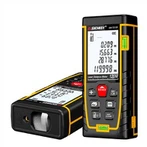5 main uses of a clamp meter
It mainly consists of a clamp head, a clamp head trigger, a hold button, a function knob, an LCD display screen, a probe socket, and two red and black probes. The clamp head is used to clamp the wire to measure current, while the red and black probes are mainly used to connect the clamp meter to measure resistance and voltage.
The clamp head is mainly used to clamp the measured wire when measuring AC current, using the principle of current transformer to induce wire current.
The trigger of the clamp head is mainly used to open and close the clamp head. When pressed, the clamp head opens, and when released, the clamp head closes.
The hold button is mainly used to hold the measured data when detecting electronic circuits, in order to facilitate reading and recording data.
The function knob is mainly designed for the multi-purpose feature of the clamp shaped meter, setting corresponding ranges for different detections.
LCD screens are mainly used to display detection data, data units, selection ranges, and other information.
The probe socket is mainly used to connect the lead plug of the probe and insulation testing accessories. Connect the red probe to the V Ω socket and the black probe to the ground terminal.
A clamp type AC ammeter is essentially composed of a current transformer and a rectifier instrument. The measured current carrying wire is equivalent to the primary winding of the current transformer, and the secondary winding on the iron core is connected to the rectifier instrument. According to a certain proportional relationship between the primary and secondary windings of the current transformer, the rectifier instrument can display the current value of the measured line.
A clamp type AC/DC meter is an electromagnetic instrument that uses the measured current carrying wire placed in the clamp as the excitation coil. The magnetic flux forms a loop in the iron core, and the electromagnetic measuring mechanism is located in the middle of the gap of the iron core, which is deflected by the magnetic field to obtain readings. Because its deflection is not affected by the measured current, it can measure AC and DC currents.






